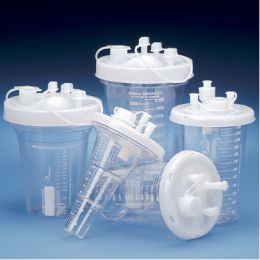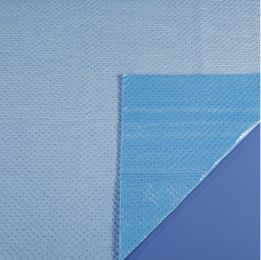
















Suction Canisters and Liners
A suction canister should have clear, easy to read printed graduations on it, and many can be used with a wall outlet, a regulator, or a central vacuum system. Its lid must fit securely when pressed on, especially during transport and disposal, to help eliminate leakage risks. Most canisters offer a filtration to trap aerosolized microorganisms and it is ideal to have a filtration efficiency of 99.5% for Staphylococcus aureus. A canister with a validated positive shut-off valve prevents overflow, and many offer larger ports for better suction.
Canisters are available in different sizes and can be combined with various accessories. Some canisters are very large for heavy fluid procedures in surgery to eliminate the need for changing canisters often. These larger ones may have a floor dolly for easy movement during and after a procedure. Some canisters are considered critical measurement canisters and are needed when small volumes of fluid must be accurately measured. The graduations may be as tiny as 5 cc increments with a total capacity of up to 300 cc. For an easy and quick at-a-glance reading, steps may be marked at 50 and 150 cc amounts.
A canister system is available in single, four, or up to eight canister set-ups with tubing connectors, solidifiers, and more for a complete kit to make the fluid management process easier. Some systems provide more suction flow power than others, while eliminating splashing and regurgitation of bodily fluids.
A drain jug is a gravity-fed fluid collection device which does away with the need to collect fluid waste with a bucket that has a dangerous open top. It can be used with cystoscopy pouches and arthroscopy drain pumps to collect the fluid from any pouch, drape or pump by utilizing gravity.
Absorbent Mats
An absorbent mat allows protection from fluid and medical stains with a laminated, impermeable backing to eliminate fluid contact to the floor, and to lock in the fluids. This also helps for easy removal of excess fluid during intense procedures, and for a faster turnaround time in the operating room. It keeps the floor dry, and decreases the chance of falls and slips for the surgical staff. Some mats are designed for wet floor usage by placing it on the wet floor to cover and absorb the area. This type does not have a laminated backing.
Some mats offer a non-skid surface for more secured comfort on the feet, while others may have a pull cord for easy pick up and disposal. Some absorbent mats incorporate a vacuum system for continuous suction to minimize the amount of fluid trapped in the mat and to help prevent fluid runoff onto the open floor. There are many sizes of absorbent mats available to absorb various amounts of saline, body fluid and blood, to accommodate a decontamination room, surgery suite, scrub sink, or lab station. By utilizing disposable absorbent mats, the number of soiled linens to launder reduces for an overall reduction in cost. Plus, many mats contain a certain amount of recycled material.
Floor Aspirators
A floor aspirator cleans up large amounts of fluid during and after a high fluid case to maintain floor dryness. It also helps protect the medical staff from falls, slips and exposure to infectious waste. Some floor aspirators can be easily moved by using a detachable handle so the surgery staff does not need to bend down or kick it for repositioning during a procedure. It also minimizes fluid exposure to the staff’s feet, legs, hands or arms. Some aspirators can suction an unlimited amount of fluid from both the top and bottom of the device for optimal protection. Other floor aspirators have a strip-like design to create a dam so the tubing from the side transfers the waste fluid to the receptacle. With a low profile design, it can easily be stepped over or rolled over without any suction loss.
Waste Disposal Accessories
Waste disposal accessories are available in combination with canisters and liners, or they can be added separately for replacement needs. There are many accessories to choose from, such as a siphon pump to empty waste containers to avoid the possibility of staff contacting the fluid. Hardware items include stands, wall mounting supplies, adapters, manifolds, brackets, collection socks, connectors, elbows and tubing. A solidifier has ingredients that solidify fluids quickly to reduce operating room turnover time and save money. Normally, the process happens in less than 2 minutes, but can vary because of density, temperature, and viscosity of the liquid.
A fluid evacuation system empties fluid from any suction canister, liner, kick bucket, collection bag, or any other collection source, and discards it directly into the sewer system. This greatly reduces the risk of contamination with blood borne pathogens. It provides an effective and efficient way to dispose of collected fluid from surgery, emergency room, and labor and delivery room procedures.
Rehabmart is pleased to carry a variety of superior quality medical waste disposal products from credentialed vendors, which include DeRoyal and Aspen Surgical.
Hulet Smith, OT
Rehabmart Co-Founder & CEO
lb